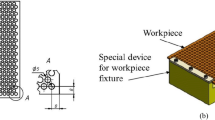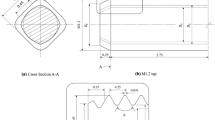Abstract
The internal threading with tap or forming tap, is a widely applied factoring process throughout industry. However, the knowledge held by the toolmakers is not transferred to the scientific literature, which justifies the small number of studies regarding this matter. This data limitation reduces the tool and cutting condition selection guide to geometrical characteristics. This current work has two main goals; the first one is to study the process behavior regarding the secondary and uncontrollable characteristics, such as thread length, tool coating, feed rate, and hole’s diameter. It also investigated the load distribution in the cutting edge for a tap operation. The second goal of this work is the investigation of the behavior of a new type of floating system in terms of torque and axial force. One of the outcomes of this work was that the torque distribution along the fillet was not uniform, with the torque of the third fillet higher than the others. The floating system tested reduces the axial force and torque by reducing synchronicity errors even in extremely conditions.
Similar content being viewed by others
References
Domblesky JP, Feng F (2002) A parametric study of process parameters in external thread rolling. J Mater Process Technol 121:341–349
Fromentin G, Bierla A, Minfray C, Poulachon G (2010) An experimental study on the effects of lubrication on form tapping. Tribol Int 43:1726–1734
Amarego EJ, Marilyn NP (2002) Predictive cutting models for the forces and torque in machining tapping with straight flute taps. Cirp - annals 51:75–78
Steiniger A, Siller A, Bleicher F (2015) Investigations regarding process stability aspects in thread tapping al – si alloys. Procedia Engineering 100:1124–1132
Pereira, I. C., Da Silva, M. B., System for compensation of synchronism errors in the process of tapping, INPT, Patent of innovation, nº BR10201501118, Brazil, 2015
Pawar S, Joshi SS (2016) Experimental analysis of axial and torsional vibrations assisted tapping of titanium alloy. J Manuf Process 22:7–20
Chowdhary, S., Ozdoganlar, B. O., Kapoor, S. G., & Devor, R. E. (2003). Modeling and analysis of internal thread forming. Journal Manufacturing Science Engeneering, pp 689–695.
Da Mota, P.R., Study of tapping operation of compacted graphite iron with cemented carbide tool. 2009. 160 p. Doctoral thesis. Federal University of Uberlandia, Uberlandia, MG, Brazil.
Veldhuis SC, Dosbaeva GK, Benga G (2007) Application of ultra-thin fluorine-content lubricating films to reduce tool/workpiece adhesive interaction during thread-cutting operations. Int J Mach Tools Manuf 47:521–528
Reiter AE, Brunner B, Ante M, Rechberger J (2006) Investigation of several PVD coatings for blind hole tapping in austenitic stainless steel. Surf Coat Technol 200:5532–5541
Carvalho AO, Brandão LC, Panzera TH, Lauro CH (2012) Analysis of form threads using flutelles taps in cast magnesium alloy (am60). Journal of Materials Processing Tecnology 212:1753–1760
Dinger G (2015) Dynamic modeling and simulation of the screwing behavior of thread forming screws. J Manuf Process 20:374–379
Author information
Authors and Affiliations
Corresponding author
Rights and permissions
About this article
Cite this article
Pereira, I.C., da Silva, M.B. Study of the internal thread process with cut and form taps according to secondary characteristics of the process. Int J Adv Manuf Technol 93, 2357–2368 (2017). https://doi.org/10.1007/s00170-017-0573-x
Received:
Accepted:
Published:
Issue Date:
DOI: https://doi.org/10.1007/s00170-017-0573-x




